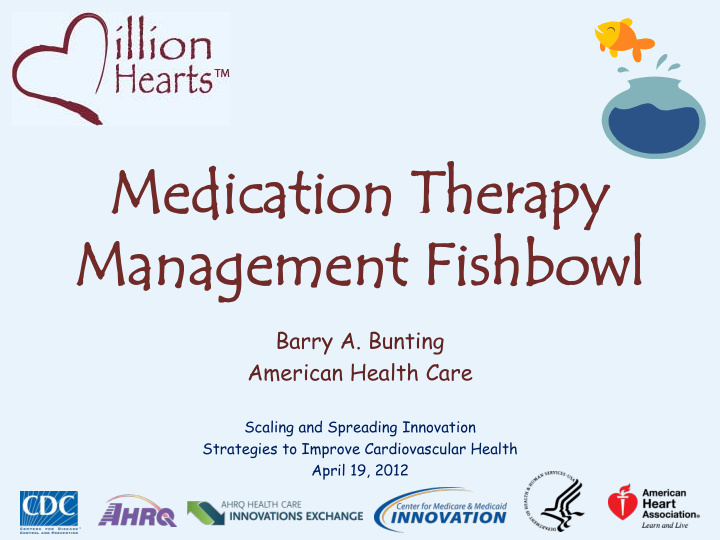



Medica ication tion T Thera rapy y Manageme ement Fis t Fishbow bowl l Barry A. Bunting American Health Care Scaling and Spreading Innovation Strategies to Improve Cardiovascular Health April 19, 2012
Descr cription of on of Innov nnovation on
As Asheville M Mod odel Patient w Chronic Condition Employers Meets every 1-3 months (between doctor visits) Physician Pharmacist/Educator -Electronic Record -Integrated Patient Data -Gaps in Care Identified -Plan of Care Reinforced -Outcome Reports Generated
Bus usine ness C Case, C Cos ost-Benef efit it, , Re Retur turn on n on Inv nvestme ment nt
Bus usine ness C Case, C Cos ost-Benef efit it, , Re Retur turn on n on Inv nvestme ment nt
Lessons ons L Learne ned/Sp /Spread Issue ues Is possible to decrease cardiovascular events & lower health care costs for • patients with cardiovascular risk with a preventive care approach ( The Asheville Project: Clinical & Economic Outcomes of a Community-Based LongTerm Medication Therapy Management Program for Hypertension & Dyslipidemia J Am Pharm Assoc. 2008;48:23-31.) Pushback from physicians has been minimal & should not be a significant • barrier to spread – Plan is to emphasize how the program helps physicians improve their “report card”, without significantly increasing their time investment – Plan is to emphasize the physician remains the decision maker, but is able to make some important decisions in a more informed manner Skepticism from payers continues to be a barrier to spread (“burned” on • programs that didn’t work) – Plan is to use the growing amount of objective data showing financial/clinical benefit of the model to overcome skepticism – Plan is to use the employer’s own data to expose their problem areas (speaks more strongly than “national” data) – Plan is to use the simplest of financial outcome measures as benchmark of success, “Does the program save more than it costs?”
Lessons ons L Learne ned/Sp /Spread Issue ues There continues to be a barrier of competing models (telephonic vs. face-to- • face, wellness approach vs. chronic disease focus) – Plan is to focus on individuals with chronic conditions taking chronic medications Patient engagement continues to be a barrier to program participation • – Plan is to emphasize the effectiveness of financial incentives (reduced Rx co- payments, premium incentives) The skill set of pharmacists matches very well with individuals with • cardiovascular risk, for whom medications are frequently a fundamental risk reduction strategy – Plan is to advocate the use of pharmacist’s clinical skills to improve therapy Pharmacists are very accessible, but not all pharmacists are available to • provide the service – Plan is to develop networks of qualified pharmacists who have time to provide service – Plan is to take advantage of pharmacy’s large national footprint (both an opportunity and a challenge)
Disclaimer The findings and conclusions in this presentation are those of the author(s) and do not necessarily represent the official position of the Centers for Disease Control and Prevention or the Agency for Healthcare Research and Quality.
Recommend
More recommend